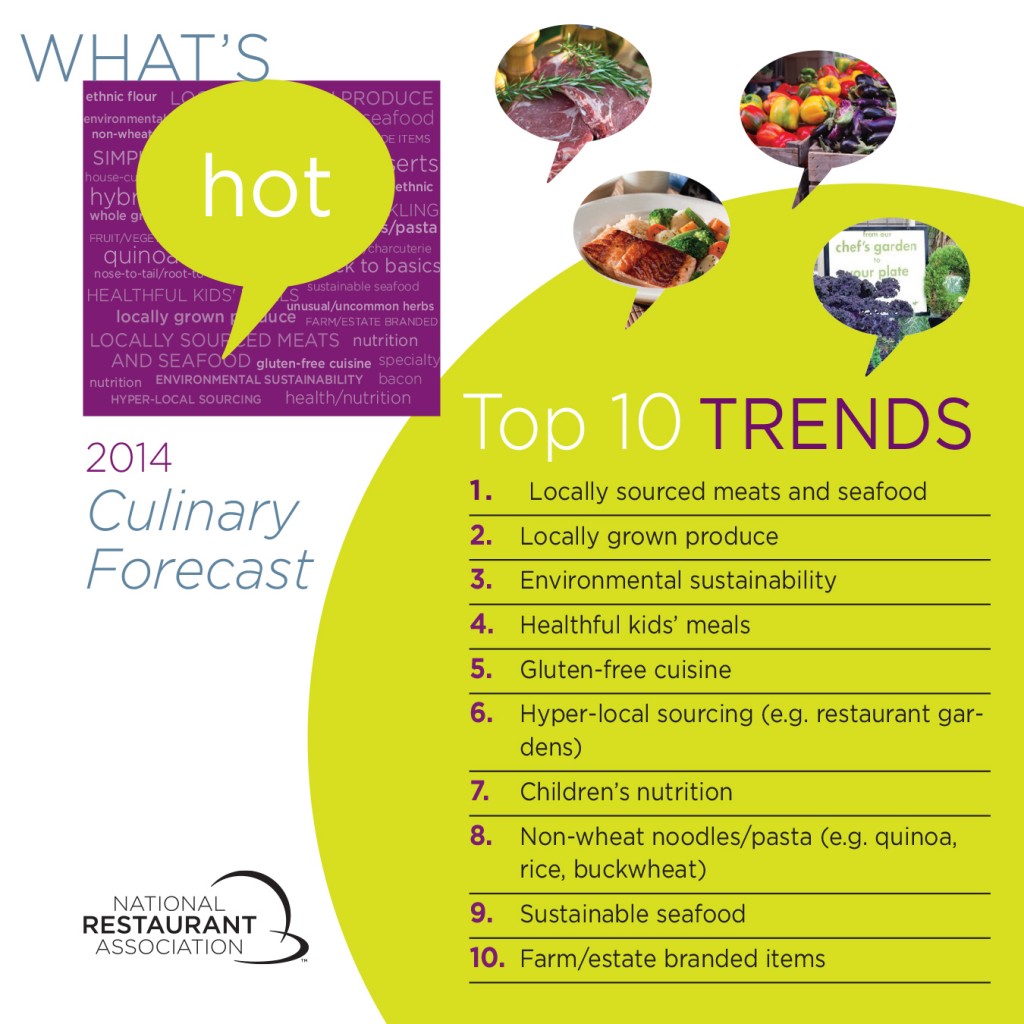What’s hot. 2014 Culinary Forecast.
A recent National Restaurant Association survey of nearly 1,300 chefs and members of the American Culinary Federation have identified the top ten food trends for 2014 as part of a What’s Hot culinary forecast for 2014. This is an indicator of what individuals are likely to see on restaurant menus this year. Among the top ten forecasted menu trends include locally sourced meats and seafood, gluten-free cuisine and sustainable seafood.
The top restaurant menus trends for 2014 focus on local sourcing, environmental sustainability and nutrition – children’s nutrition in particular. These trends have been gaining momentum for several years, indicating that these wider themes influence the culinary scene.
“Today’s consumers are more interested than ever in what they eat and where their food comes from, and that is reflected in our menu trends research. True trends – as opposed to temporary fads – show the evolution of the wider shifts of our modern society over time, and focus on the provenance of various food and beverage items, unique aspects of how they are prepared and presented, as well as the dietary profiles of those meals,” explained Hudson Riehle, senior vice president of the National Restaurant Association’s research and knowledge group.
Top 20 food trends for 2014:
1. Locally sourced meats and seafood;
2. Locally grown produce;
3. Environmental sustainability;
4. Healthful kids’ meals;
5. Gluten-free cuisine;
6. Hyper-local sourcing (e.g. restaurant gardens);
7. Children’s nutrition;
8. Non-wheat noodles/pasta (e.g. quinoa, rice, buckwheat);
9. Sustainable seafood;
10. Farm/estate branded items;
11. Nose-to-tail/root-to-stalk cooking (e.g. reduce food waste by using entire animal/plant);
12. Whole grain items in kids’ meals;
13. Health/nutrition;
14. New cuts of meat (e.g. Denver steak, pork flat iron, tri-tip);
15. Ancient grains (e.g. kamut, spelt, amaranth);
16. Ethnic-inspired breakfast items (e.g.Asian-flavored syrups, Chorizo scrambled eggs, coconut milk pancakes);
17. Grazing (e.g. small-plate sharing/snacking instead of traditional meals);
18. Non-traditional fish (e.g. branzino, Arctic char, barramundi);
19. Fruit/vegetable children’s side items;
20. Half-portions/smaller portions for a smaller price;
In addition, the What’s Hot in 2014 survey found that the top five alcohol and cocktail trends will be micro-distilled/artisan spirits, locally produced beer/wine/spirits, onsite barrel-aged drinks, culinary cocktails (e.g. savory, fresh ingredients), and regional signature cocktails.
When asked which current food trend will be the hottest menu trends 10 years from now, environmental sustainability topped the list, followed by local
sourcing, health-nutrition, children’s nutrition and gluten-free cuisine.
The five items with the highest ranking as a waning trend in 2014 were foam/froth/air, bacon-flavored chocolate, fish offal, gazpacho, and fun-shaped
children’s items. The five items with the highest points as perennial trends next year were fried chicken, Italian cuisine, frying, barbeque, and Eggs
Benedict.
The five items that gained most in trendiness since last year in the annual survey were nose-to-tail/root-to-stalk cooking, pickling, ramen, dark greens, and Southeast Asian cuisine. The five items with the largest drop in “hot trend” rating were Greek yogurt, sweet potato fries, new cuts of meat, grass-fed beef, and organic coffee.
Compared with five years ago, items that have remained top 20 food trends include locally grown produce, healthful kids’ meals, gluten-free cuisine, sustainable seafood, and health/nutrition. Items that have dropped substantially down the list from the top 20 food trends in 2009 include gelato, micro- greens, flatbreads, tapas/meze/dim sum, and dessert flights.
Also included in the What’s Hot in 2014 survey were questions about other trends. Nearly six out of 10 (59 percent) of the chefs said they always make efforts to adjust dishes and recipes to be more healthful, while one-third (33 percent) said they cook with nutrition in mind, but that not all recipes are easily adjusted.
When it comes to technology trends, the chefs ranked menus on tablet computers as the top trend, followed by smartphone apps for consumers (ordering, reservations, daily deals, etc.), smartphone apps for chefs (recipes, table management, POS tracking, etc.), mobile payment and social media marketing.


